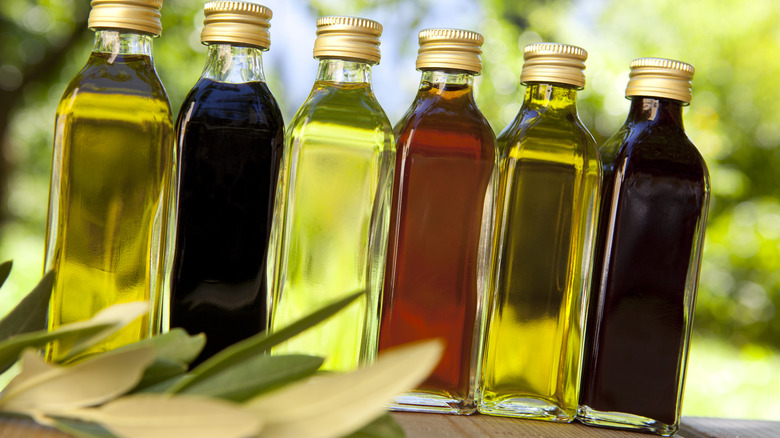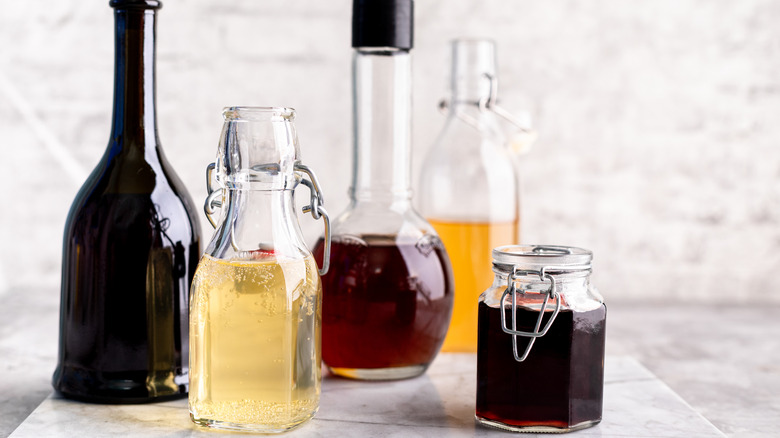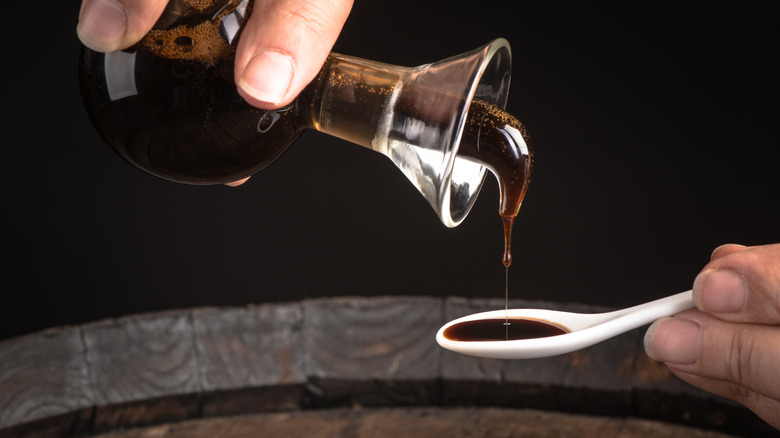High-Quality Vinegar Production Shares A Lot In Common With Winemaking
You've probably never thought about how that bottle of balsamic vinegar in the back of your pantry gets made, and that's not really surprising. Although a lot of vinegar is mass-produced and many kinds of vinegars have overlapping ingredients, when you delve into high-end vinegars, a whole new world opens up.
The word "vinegar" comes from the French phrase "vin aigre," which means "sour wine." Vinegar is made through a process similar to wine-making, where yeast consumes sugars in grapes or other base ingredients, fermenting the mixture to produce an alcoholic liquid. The difference is that vinegar is then left to further oxidize, removing the alcohol and making the product highly acidic. If you were to open a bottle of wine and leave it out for a few weeks, it would turn into vinegar.
When it comes to high-quality vinegars, producers often monitor the fermentation as closely as winemakers oversee the development of their wines. Formal categorizations and vinegar-making practices exist to support the development of top-notch vinegars.
How high-quality vinegar is made
Consider balsamic vinegar as an example. Authentic balsamic vinegar from Modena and Reggio Emilia in Italy goes through a fermentation and maturation process that lasts a minimum of 12 years. The bottles are marked with colored caps to indicate their age and bear the label "Aceto Balsamico Tradizionale." This is a D.O.P. (Denominazione di Origine Protetta), or Protected Designation of Origin stamp, similar to the D.O.C. designation used in the wine industry.
The types of barrels that can be used for aging balsamic vinegar — such as oak, cherry, juniper, and chestnut — are carefully selected to produce specific flavors. This is much the same way wine barrels are chosen: either to add flavor or to avoid altering the wine's existing taste. This is generally done by selecting either flavorful new barrels or more neutral, older barrels.
During the barrel-aging process, some vinegar evaporates, commonly referred to as the "angel's share" in the alcohol industry. The barrels are topped off whenever they lose volume, mimicking processes used with fortified wines like port and sherry.
Keeping standards high
Regulatory bodies, such as the Balsamic Vinegar of Modena Consortium, enforce strict quality and authenticity standards. Vinegars that fail to meet these standards cannot use the official name "Aceto Balsamico Tradizionale." Alternate wording on a vinegar bottle's label suggests it is an imitation product. This level of distinction is rare in food products and is more similar to regional wine classifications like champagne, which are overseen by the Comité Champagne organization.
Ponti, an Italian brand that produces traditional balsamic vinegar in Modena, is well-versed in these stringent requirements but maintains that the end results justify the effort. "We've always approached the art of vinegar-making with the understanding that it shares fundamental similarities with the wine industry," Giacomo Ponti, the company's president, told Food Republic. "Over the course of our 230-year history, we've consistently sought to uphold the values of terroir, tradition, and craftsmanship, principles commonly associated with the world of fine wine."



